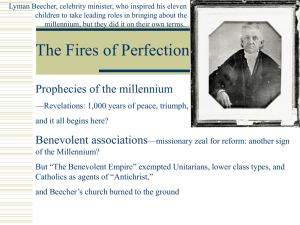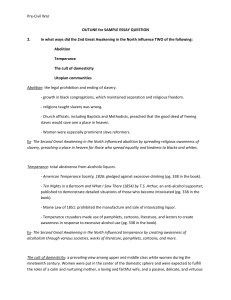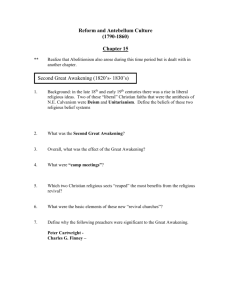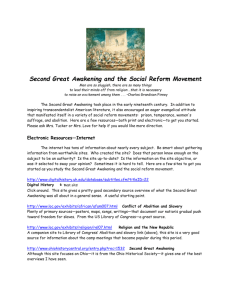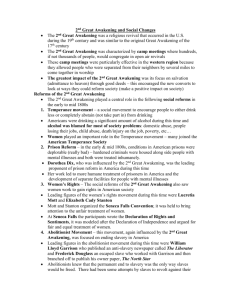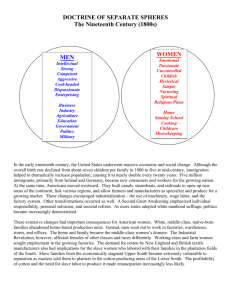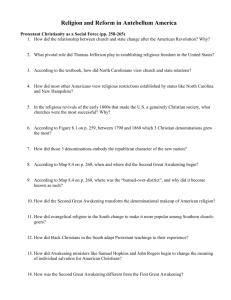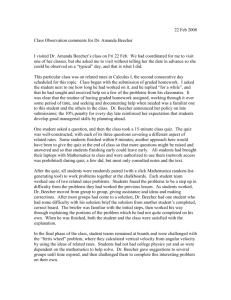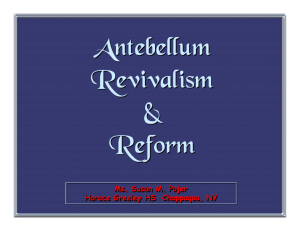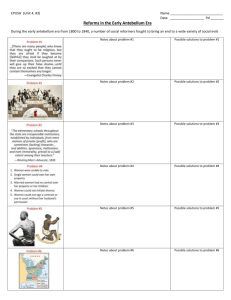Chapter 11-1
advertisement
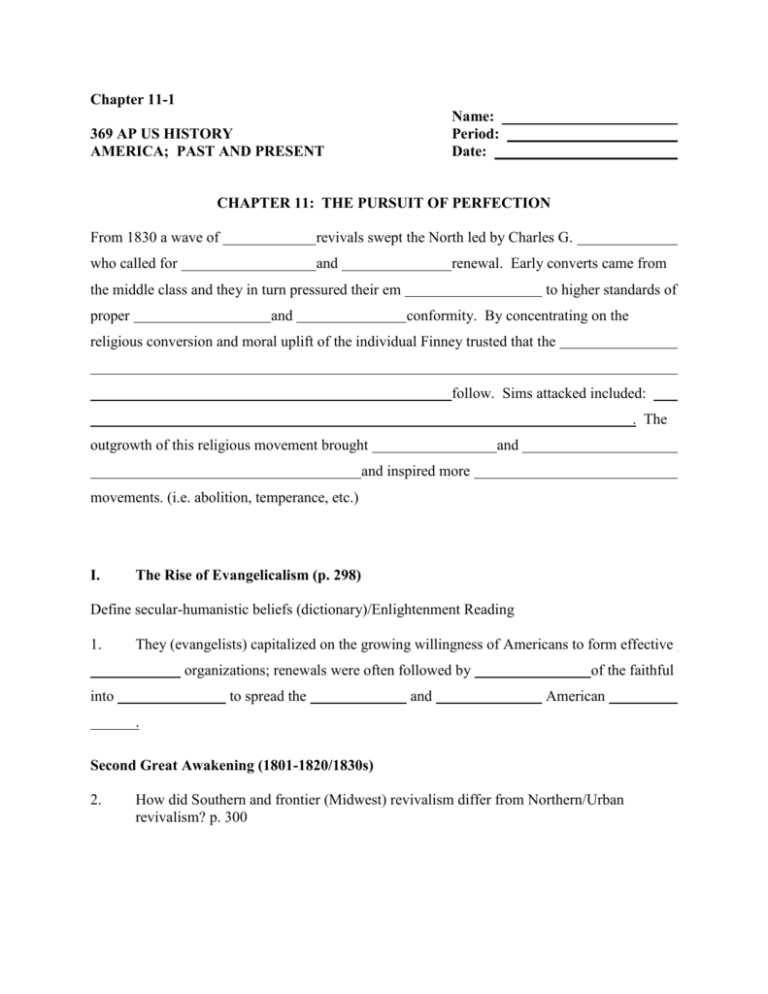
Chapter 11-1 Name: Period: Date: 369 AP US HISTORY AMERICA; PAST AND PRESENT CHAPTER 11: THE PURSUIT OF PERFECTION From 1830 a wave of revivals swept the North led by Charles G. who called for and renewal. Early converts came from the middle class and they in turn pressured their em proper and to higher standards of conformity. By concentrating on the religious conversion and moral uplift of the individual Finney trusted that the follow. Sims attacked included: . The outgrowth of this religious movement brought and and inspired more movements. (i.e. abolition, temperance, etc.) I. The Rise of Evangelicalism (p. 298) Define secular-humanistic beliefs (dictionary)/Enlightenment Reading 1. They (evangelists) capitalized on the growing willingness of Americans to form effective organizations; renewals were often followed by into to spread the and of the faithful American . Second Great Awakening (1801-1820/1830s) 2. How did Southern and frontier (Midwest) revivalism differ from Northern/Urban revivalism? p. 300 Chapter 11-2 3. List the differences (p. 300-301) Deism/Unitarianism Calvinists/Neo-Calvinists (Finney)/(Beecher) 4. Reforms inspired by the middle class who had taken part in the Great Awakening included a) dueling, gambling, prostitution b) *American Temperance Society (1826) p.303 c) Explain the term “benevolent empire” p. 303 5. In this era hypothesize as to why church and state complimented one another: II. Domesticity and Changes in the American Family p.304 6. Women were increasingly to the domestic circle, but assumed a within it. Chapter 11-3 7. Recount the major changes in marriage/sex roles and childhood (fill in) a) Triumph of b) Marriage had become more a matter of exertion of c) In law the husband remained the d) Who held legal authority over property and children? and less an *Cult of True Womanhood/Ideology or Cult of Domesticity/Republican Motherhood 1820s/1830s (all of these phrases are interchangeable for the same concept) *Catherine Beecher e) By the Nineteenth century childrens’ upbringing changed dramatically. Describe below what happened: f) g) III. Size of the Family= Birth Control Methods: Institutional Reform—p. 307 Reformers worked to establish or improve public institutions that were designed to shape individual character and instill a capacity for self-discipline. Hypothesize as to why this might be happening: *Role of Public Schools/Horace Mann *Role of Asylums/Dorothea Dix Chapter 11-4 8. Explain the splits in the following organizations: Temperance Society (1836) American Peace Society (1828) *American Colonization Society (1817) *William Lloyd Garrison/American Anti-Slavery Society (1833) *Frederick Douglas 9. was a major cause of antiablititionist violence in the _________. tended to fear that and social competition with would increase if abolitionists succeeded in citizens. By the end of the In the slaves and making them the abolitionist movement was under great stress. abolitionism caused a strong counter reaction and helped inspire a more militant and uncompromising of slavery. *Declaration of Sentiments/Seneca Falls, New York (1848) p. 317 10. Utopian Socialism—As expressed by Charles Fourier: communities in which everyone did a . of the work and tasks were allotted to make use of the natural abilities and instincts of the members. Why were so many of these communities short-lived? *Transcendentalism *Emerson/Thoreau 11. Pre-Civil War reform was both a of America’s promise. It condemned the It sought to (p. 320) of American reality and a CHAPTER 11 ID’S 1801-1820/1830’s SECOND GREAT AWAKENING Pgs. 299-300 The Second Great Awakening started on the southern frontier in 1801. The vehicle of the Awakening was the camp meeting. Generally Methodist or Baptists evangelists would organize a meeting at which people could get baptized, married, or have a communal religious experience. Although most of the people who attended the meetings were religious, hecklers attended as well. The evangelists would sometimes be able to convert these people. The frontier Awakening strengthened personal piety and morality, but it didn’t stimulate organized benevolence or social reform. The Awakening in the North was much different. The Awakening started in the early 1800’s to combat the Unitarians, a group of men from Yale who followed Deism. The leading Northern evangelist was Lyman Beecher. Beecher followed the ideas of Timothy Dwight, the president of Yale. Dwight said that every man could overcome his natural temptation to sin. Beecher preached in many Congregational churches. Another evangelist was Charles G. Finney. Finney preached in Congregational and Presbyterian churches in New York. Finney appealed directly to a person’s heart rather than to doctrine or reason. He said that people could be totally sin-free, like God. Beecher and Finney disagreed with each other, and they were never able to reconcile their differences. The Great Awakening in the North started a flood of social reforms. Groups like the American Bible Society and the American Tract Society put out religious texts, while other groups tried to wipe out dueling, gambling, prostitution, and drinking. -21826 AMERICAN TEMPERANCE SOCIETY Pg. 303 Lyman Beecher’s most effective social reform was his attack on alcohol. Alcohol was a real problem in America in 1826. Whiskey was cheaper than milk and safer than water. Hard liquor was used as a table beverage, and it was drunk by adults and children alike. Alcoholism was great problem. Reformers saw alcohol as a source of crime and disorder. It also was a danger to the family. Wealthier people were afraid that lower class mobs would get drunk and destroy private property. In 1826, a group of reformers organized the American Temperance Society. The Society’s purpose was to encourage abstinence from hard liquor. It sent out literature, held essay contests, and organized revival meetings. The Society was effective, forming many local branches and making abstinence a sign of respectability. 1820’s/1830’s CULT OF TRUE WOMANHOOD Pgs. 304-305 The Cult of True Womanhood was the term applied to the role of the woman during the first half of the 1800’s. Otherwise known as the ideology of domesticity or Republican motherhood, the woman’s role was spiritual head of the home. It was women who went to the evangelical sermons and enrolled in churches. It was their job to pass this spiritual goodness onto their children and their husband. Part of this developed because the husband was away at work all day and the wife was at home due to changing work conditions. The woman was the head of the household because she was there all day. She had to raise her children to be good citizens and provide a shelter for her husband from the cruel outside world. -31820’s/1830’s CATHERINE BEECHER Pg. 306 Catherine Beecher was one of Lyman Beecher’s daughters. She wanted to make teaching a woman’s profession. She thought that since woman were supposed to be pious and good, that they should pass that on to young men through the schools. This would help keep America from corruption and materialism. Beecher realized that women couldn’t reform their husbands, but they could reform their children. 1820-1850 ROLE OF PUBLIC SCHOOLS/HORACE MANN Pgs 307-311 Before 1820, education was very haphazard. Basically, only the rich were educated in the North, and almost no one was educated in the South. During the 1820’s and the 1830’s the push for public education was started by the workers because they thought it would be way to close the gap between rich and poor. The middle class took up the cause and provided the momentum needed for public education to become the norm. The spokesman for common schools was Horace Mann of Massachusetts. In 1837 he persuaded the legislature to create a public school system. He resigned his place as a representative to become the first secretary of the school board. Mann felt that children were clay that could be molded to a state of perfection. He didn’t believe in corporal punishment. He also justified the use of property taxes to pay for the schools because private property was held in trust for the good of the community. Mann’s schools taught morality rather than the normal school subjects. Often, they alienated the poorer classes because they tried to impose a uniform culture on varied people. -41820’s-1830’s ROLE OF ASYLUMS/DOROTHEA DIX Pgs. 311-312 During the 1820’s and 30’s state-supported asylums, prisons, and poorhouses were set up. The prisons were admired because they used solitary confinement as a way to rehabilitate inmates. The institutions were supposed to take the place of the family. They didn’t succeed. Inmates were subjected to strict daily routines. Overcrowding was common and inmates were often beaten for discipline. Dorothea Dix saw this and between 1838 and the Civil War lobbied for asylum and prison reform. She succeeded and many new state hospitals and prisons were opened to relieve the overcrowding. 1817 AMERICAN COLONIZATION SOCIETY Pg. 313 The American Colonization Society was one of the first abolitionist groups in the U.S. The colonizationsists said that slavery was evil, but it couldn’t be eradicated without the support of the southern slaveholders. They said that freed slaves should be shipped to Africa so a race war wouldn’t begin. In 1821, the society established Liberia. -51833 WILLIAM LLOYD GARRISON/AMERICAN ANTI-SLAVERY SOCIETY Pgs. 313-314 Colonization did nothing to stop the spread of slavery. William Lloyd Garrison and other called for immediate emancipation without emigration. Garrison published an abolitionist journal called the Liberator in 1831. In 1833 he established the American Anti-Slavery Society. The Society believed that colonization was a slaveholders plot to remove troublesome blacks. The American Anti-Slavery Society replaced the American Colonization Society as the major force for abolitionists. 1838 FREDERICK DOUGLASS Pg. 314 Frederick Douglass was a slave who escaped in 1838. He became on of the most important spokespeople for the abolitionist movement. -61848DECLARATION OF SENTIMENTS/SENECA FALLS, NEW YORK Pg. 317 The feminist movement was really started by Lucretia Mott and Elizabeth Cady Stanton. These two women were a part of Garrison’s Anti-Slavery Society. After the Society walked out of a London convention because the people refused to seat the women, Stanton and Mott decided to start their own movement. They started their feminist campaign. The most important point of the campaign was the convention in Seneca Falls, New York. The Declaration of Sentiments put out at the convention called for the right to vote, and the freedom from laws giving husbands control of property and children. 1840’s TRANSCENDENTALISM/EMERSON & THOREAU Pgs.318-319 Transcendentalism was a philosophical movement that said that man could transcend material reality and reach a higher plane of reason. Transcendentalism was the American form of romanticism that emerged in the 1800’s. Ralph Waldo Emerson was the first transcendentalist. He set out transcendentalist doctrine. He came up with the idea of oversoul. One of his followers, Henry David Thoreau, acted out Emerson’s ideas. Between 1845 and 1847 Thoreau lived on Walden Pond alone. 369 AP US HISTORY AMERICA: PAST AND PRESENT QUIZ: CHAPTER 11 Name Period Date Multiple Choice Circle the one alternative that best completes the statement or answers the question. 1. Pious Protestants of the early nineteenth century were concerned about a. the spread of secular humanism. b. the lack of respect for the example of Christian orthodoxy set by the Founding Fathers. c. the increase in established state churches. d. declining membership in frontier churches, such as the Baptist and the Methodist. 2. Camp meetings on the frontier provided all of the following except a. an emotional outlet. b. a sense of community. c. a rational appeal to moral behavior. d. a rite of passage for a young man or woman. 3. The Second Great Awakening in the North especially appealed to a. Unitarians, searching for a revival theology consistent with their view of the Trinity. b. small-to medium-sized town dwellers with New England Puritan backgrounds. c. urban workers and mechanics, looking to revivals for relief from daily work problems. d. rural planters, seeking a method to help them with their drinking problems. 4. Temperance reformers opposed public drunkenness because it a. spawned crime and vice. b. was a threat to the family. c. was a threat to private property and public order. d. all of the above. 5. The “Cult of True Womanhood” or the “ideology of domesticity” achieved a. true equality for men and women. b. some equality for women, especially in the ownership of property. c. some equality for women, especially in religion and morals for the family and as a companion for her husband. d. nothing that was not already accomplished in the colonial era. 6. The rise of the “Cult of True Womanhood” was caused by a. a division in the working lives of men and women. b. successful Supreme Court decisions. c. the high number of women in the teaching profession. d. agitation by organized groups. 7. The new literature that glorified the “Cult of True Woman hood” appealed especially to a. relatively affluent women. b. single women. c. working-class wives. d. rural and mountain wives. 8. The nineteenth century has been called the “century of the child” for which of the following reasons? a. The average family had more children. b. Birth control and abortion were not available. c. Children were an economic asset to the urban family. d. The family became more child-centered. 9. The purpose of public education as seen by Horace Mann was to teach a. cultural plurality. b. morality and discipline. c. freedom, liberty, and other ideals of the American Revolution. d. that the rights of private property are absolute. 10. The “discovery of the Asylum” a. occurred because economic development led to the rise of urban areas and the decline of cohesive villages. b. resulted in placing lunatics and paupers with families in small towns. c. led to the abolition of solitary confinement. d. happened after a Calvinist revival meeting. 11. William Lloyd Garrison and the American Anti-Slavery Society advocated a. gradual emancipation with compensation to owners. b. gradual emancipation without compensation to owners. c. immediate abolition of slavery and colonization of blacks in Africa. d. immediate abolition of slavery without emigration.. 12. Which of the following caused a formal split in the American Anti-Slavery Society? a. Garrison’s attack of the clergy b. racism in the North c. Garrison’s support for women’s rights d. Black leadership in the organization 13. The primary catalyst for the women’s rights movement of the 1830s was the a. “Cult of True Womanhood” b. abolitionist movement c. Rise of free public education d. Second Great Awakening 14. The “Declaration of Sentiments” of the Seneca Falls meeting of 1848 stated that a. men had established a tyranny over women. b. men should willingly accept the cult of domesticity. c. women should have equal rights but only in their own spheres. d. women should have the right to vote, but not necessarily equality within the family. 15. The utopian socialist communities of the 1830’s and 1840’s were a. all secular with no religious basis. b. variable in organization and leadership. c. based on the idea of “free love”. d. based on a purely American idea.
